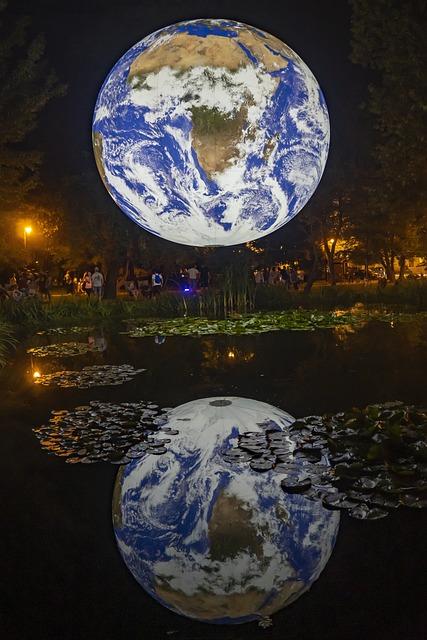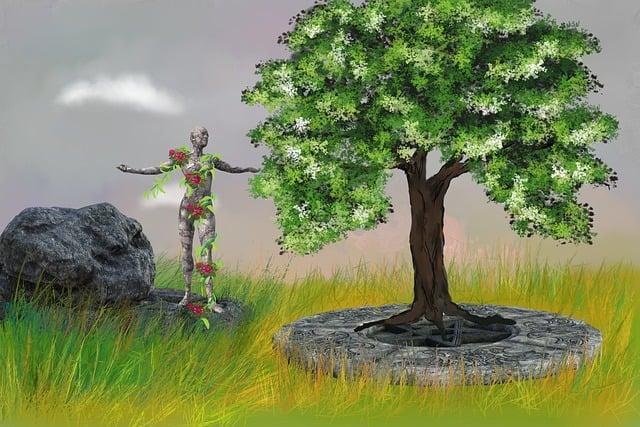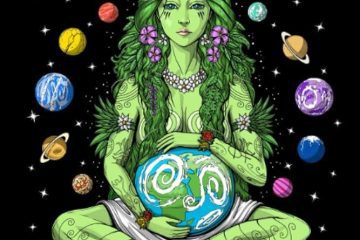Table of Contents
- Understanding the Gaia Hypothesis and Its Ecological Implications
- Exploring the Interconnectedness of Life Through Gaias Lens
- The Role of Feedback Mechanisms in Earths Biosphere
- Practical Applications of the Gaia Hypothesis in Environmental Conservation
- Challenges and Critiques: A Balanced View on the Gaia Hypothesis
- Q&A
- Final Thoughts

Understanding the Gaia Hypothesis and Its Ecological Implications
The Gaia Hypothesis, proposed by scientist James Lovelock in the 1970s, posits that the Earth functions as a single, self-regulating organism. This concept challenges the traditional view of ecological systems, asserting that living organisms interact with their inorganic surroundings to maintain conditions conducive to life. According to this hypothesis, the biosphere, atmosphere, geosphere, and hydrosphere are interconnected in a complex network that supports the maintenance of life on our planet. More intriguingly, it suggests that life not only survives but actively influences the environment, creating a balance that promotes sustainability.
Understanding this hypothesis reveals significant ecological implications, particularly in how we address environmental challenges. For instance, it encourages the exploration of holistic approaches to environmental management, where actions taken in one area can have cascading effects on others. Such an interconnected view promotes concepts like biomimicry and sustainable design, inspiring innovative solutions that mimic natural processes. Additionally, it emphasizes the need for preserving biodiversity, as each species plays a role in this intricate web, impacting the overall health of the planet.
Furthermore, the Gaia Hypothesis has paved the way for interdisciplinary studies, merging ecology, climatology, and even philosophy. By viewing Earth as a self-regulating system, scientists have begun to explore how climate change, pollution, and other anthropogenic effects disrupt this balance. To illustrate these impacts, consider the table below, which summarizes changes in key ecological parameters influenced by human activity:
| Impact | Effect on Gaia System | Potential Solutions |
|---|---|---|
| Deforestation | Loss of biodiversity, altered carbon cycles | Reforestation, sustainable logging practices |
| Greenhouse Gas Emissions | Climate change, sea-level rise | Transition to renewable energy, carbon offsetting |
| Pollution | Ecosystem degradation, health risks | Regulation of pollutants, waste management |

Exploring the Interconnectedness of Life Through Gaias Lens
At the heart of the Gaia hypothesis lies the concept that all living organisms on Earth, along with their inorganic surroundings, form a complex, interdependent system. This intricate web of life operates through numerous feedback loops, where changes in one component can create cascading effects throughout the ecosystem. Consider how photosynthesis contributes not only to the energy needs of plants but also to regulating atmospheric gases, illustrating a fundamental principle of interconnectedness.
Exploring this concept further, we can identify several core elements that exemplify the relationships within the Gaia system:
- Climate Regulation: The collective actions of organisms influence climate patterns, affecting everything from rainfall to temperature.
- Nutrient Cycling: Organisms work symbiotically to recycle nutrients, ensuring that energy is conserved and efficiently used within ecosystems.
- Resilience: Diverse biological networks enhance the stability of ecosystems, allowing them to adapt and recover from disturbances.
The implications of the Gaia hypothesis extend beyond ecology; they provide a framework for understanding our role within the global environment. For instance, changes such as pollution or deforestation disrupt these interconnections and can result in significant ecological consequences. A closer examination of these impacts can enhance our appreciation for the delicate balance of life and foster a more sustainable approach to living on this planet, urging humanity to become more conscious of its contributions to the collective health of Earth.
The Role of Feedback Mechanisms in Earths Biosphere
At the heart of Earth’s biosphere lies a complex network of feedback mechanisms that orchestrate the delicate balance of life. These mechanisms operate silently yet powerfully, maintaining homeostasis within ecosystems and regulating overall planetary health. Among these essential processes, positive feedback loops can amplify changes, while negative feedback loops act as stabilizers, ensuring that changes do not spiral out of control. This interplay fosters resilience, allowing ecosystems to adapt and thrive despite environmental fluctuations.
The intricacies of these feedback systems are illustrated through various interactions in nature. For example, consider the relationship between plants and atmospheric carbon dioxide. As photosynthesis takes place, plants absorb CO2, thereby reducing greenhouse gas concentrations and influencing climate patterns. Conversely, as temperatures rise due to increased atmospheric CO2, plant respiration rates can also increase, potentially leading to a further rise in CO2. This dynamic exemplifies how both processes are intricately connected and continually influence each other in a feedback mechanism essential to life on Earth.
Moreover, feedback mechanisms extend beyond terrestrial ecosystems to include aquatic environments. The interactions between aquatic life and nutrients play a critical role in regulating water quality and ecosystem productivity. For instance, when nutrient levels rise due to runoff, algae blooms can occur, which in turn deplete oxygen levels in water bodies. This scenario exemplifies negative feedback where the proliferation of algae ultimately leads to detrimental effects, showcasing how interconnected systems can affect overall biodiversity. The continual dance of these feedback loops reveals a deeper truth about Earth: it is not merely a collection of biological components but a unified organism that thrives on balance and interdependence.

Practical Applications of the Gaia Hypothesis in Environmental Conservation
The Gaia Hypothesis, which posits that Earth functions as a self-regulating, interconnected system, has sparked innovative approaches in environmental conservation. One practical application of this idea is ecosystem-based management, which emphasizes the importance of maintaining biodiversity and ecosystem services. By understanding the intricate relationships between species and their habitats, conservationists can develop strategies that not only protect individual species but also enhance the health of entire ecosystems. This holistic perspective allows for more effective restoration of damaged environments and promotes long-term sustainability.
Another significant application lies in climate change mitigation. The Gaia Hypothesis encourages a systemic view of the planet’s components, highlighting how human actions can disrupt the balance of natural systems. This understanding drives conservation efforts towards implementing practices such as reforestation, soil regeneration, and wetland restoration. Engaging with these methodologies not only aids in carbon sequestration but also restores habitats, supporting the myriad of life forms that depend on them. By fostering resilient ecosystems, humanity can better adapt to and mitigate the effects of climate change while preserving the planet’s biodiversity.
Furthermore, the Gaia Hypothesis underlines the significance of community engagement in conservation efforts. Initiatives that promote local stewardship of natural resources reflect the interconnectedness of our ecological communities. Examples of such initiatives include:
- Citizen Science Programs: Involving the public in data collection to monitor ecological health.
- Sustainable Agriculture: Encouraging practices that enhance soil health and biodiversity.
- Marine Protected Areas: Empowering local communities to manage marine resources sustainably.
Through these community-focused approaches, individuals recognize their role within the larger ecosystem, fostering a deep connection to the environment and promoting the collective responsibility of stewardship.

Challenges and Critiques: A Balanced View on the Gaia Hypothesis
The Gaia Hypothesis, while groundbreaking in its perspective, faces several challenges and critiques from the scientific community. One significant concern is the difficulty in providing empirical evidence to support the idea that the Earth functions as a self-regulating system. Critics argue that many of the patterns associated with planetary homeostasis could be explained by natural selection rather than a holistic, intentional process. This debate leads to pointed questions about the hypothesis’s testability and its reliance on interpretative frameworks rather than rigorous scientific metrics.
Moreover, some skeptics contend that the hypothesis risks anthropomorphizing the Earth— attributing human-like qualities and intentions to a geological and biological system that does not possess consciousness. This view prompts substantial discussion regarding the epistemological implications of viewing Earth as a living organism. Detractors emphasize that this perspective could lead to a flawed understanding of ecological processes, oversimplifying the complex dynamics involved in interactions between different species and their environments.
Despite these critiques, the Gaia Hypothesis has undeniably spurred critical discussions on ecosystem sustainability and the interplay between living organisms and their surroundings. Proponents highlight its impact in promoting interdisciplinary research, bridging biology, ecology, and Earth sciences. The debate surrounding its validity highlights the importance of questioning established paradigms and encourages ongoing inquiry into how humans can live more harmoniously within the natural world.
Q&A
Q&A on the Gaia Hypothesis
Q1: What is the Gaia Hypothesis? A1: The Gaia Hypothesis, first popularized by scientist James Lovelock in the 1970s, proposes that the Earth functions as a self-regulating system. It posits that living organisms and their inorganic surroundings are interconnected in a way that maintains the conditions necessary for life. Essentially, it suggests that the biosphere interacts with the atmosphere, geosphere, and hydrosphere to promote a stable climate and environment conducive to life.Q2: How does the Gaia Hypothesis explain the relationship between life and the planet? A2: The hypothesis asserts that life on Earth actively influences and regulates its environment. For instance, plants modify the atmosphere by producing oxygen, while microorganisms contribute to nutrient cycling. This cooperative interaction leads to a feedback loop where changes in one component result in adjustments across the system, promoting a balance that supports various life forms.
Q3: What are some criticisms of the Gaia Hypothesis? A3: Critics argue that the Gaia Hypothesis lacks empirical support and can be overly broad. Some scientists believe it anthropomorphizes the Earth, suggesting it has a purpose or intention, which they argue is not scientifically valid. Others point out that natural selection, rather than a global regulatory system, is a more accurate explanation for how life evolves and interacts with its environment.
Q4: Can the Gaia Hypothesis be applied to modern environmental issues? A4: Yes, many advocates of the Gaia Hypothesis use it to address contemporary environmental challenges. It highlights the importance of understanding ecosystems as interconnected networks where changes can have widespread consequences. By applying this holistic perspective, it can inspire conservation efforts and sustainable practices that consider the balance and health of the planet as a whole.
Q5: How has the Gaia Hypothesis influenced scientific thought? A5: The Gaia Hypothesis has sparked interdisciplinary discussions, bridging fields such as ecology, Earth sciences, and philosophy. It encourages a more comprehensive view of life and its impact on the Earth, leading to the development of fields like Earth system science. Its influence can also be seen in movements promoting sustainability, climate change awareness, and a deeper understanding of human interactions with the planet.
Q6: What are some real-world examples that support the Gaia Hypothesis? A6: One classic example is the regulation of atmospheric gases. The balance of oxygen, carbon dioxide, and other gases is closely linked to biological processes. Coral reefs also demonstrate these principles where the symbiotic relationship between corals and algae creates a habitat that supports diverse marine life, showcasing how organisms can shape their environment. Another example includes the role of forests in influencing weather patterns and climate regulation through transpiration.
Q7: Is the Gaia Hypothesis universally accepted? A7: While the Gaia Hypothesis has garnered significant interest and support, especially in ecological and environmental fields, it remains a topic of debate within the scientific community. Some view it as a metaphorical framework while others advocate for its empirical foundations. its acceptance varies based on the context in which it is discussed and the specific scientific or philosophical viewpoints involved.
This exploration of the Gaia Hypothesis invites further contemplation on the intricate dance between life and the planet, emphasizing a perspective where everything is interconnected, reminding us that our actions resonate beyond individual lifestyles into the vast web of life on Earth.



0 Comments